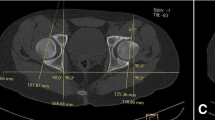Abstract
Purpose
While the femoral deformity in post slipped capital femoral epiphysis (SCFE) hips has been implicated in the development of femoral acetabular impingement, little has been studied about the acetabular side. The purpose of our study was to determine the frequency of morphologic changes suggestive of acetabular retroversion in patients who have sustained a SCFE.
Methods
IRB approval was obtained and the records of patients from 1975 to 2010 were searched for ICD-9 codes for SCFE. A total of 188 patients were identified for the study. Two observers evaluated AP radiographs for evidence of acetabular retroversion as characterized by the presence of either an ischial spine sign or a crossover sign. Demographic data, date of onset, and treatment were recorded. For analysis, the right hip was used in patients with bilateral involvement.
Results
Of the 188 patients identified, 5 patients had an incorrect diagnosis and 41 patients had missing or inadequate films, leaving 142 patients (284 hips) for review. 57 patients (114 hips) had bilateral SCFE and 85 patients had unilateral SCFE. 79 % (n = 45) of the right hips with bilateral SCFE and 82 % (n = 70) of the unilateral involved hips had at least one sign of retroversion. Uninvolved hips had at least one sign of retroversion 76 % (n = 65) of the time.
Conclusions
When compared to previously published values for normal patients, patients with SCFE appear to have an increased incidence of acetabular retroversion.
Similar content being viewed by others

References
Rab GT (1999) The geometry of slipped capital femoral epiphysis: implications for movement, impingement, and corrective osteotomy. J Pediatr Orthop 19(4):419–424
Leunig M, Casillas MM, Hamlet M, Hersche O, Nötzli H, Slongo T, Ganz R (2000) Slipped capital femoral epiphysis: early mechanical damage to the acetabular cartilage by a prominent femoral metaphysis. Acta Orthop Scand 71(4):370–375
Dodds MK, McCormack D, Mulhall KJ (2009) Femoroacetabular impingement after slipped capital femoral epiphysis: does slip severity predict clinical symptoms? J Pediatr Orthop 29(6):535–539
Ganz R, Parvizi J, Beck M, Leunig M, Nötzli H, Siebenrock KA (2003) Femoroacetabular impingement: a cause for osteoarthritis of the hip. Clin Orthop Relat Res 417:112–120
Fujii M, Nakashima Y, Yamamoto T, Mawatari T, Motomura G, Matsushita A, Matsuda S, Jingushi S, Iwamoto Y (2010) Acetabular retroversion in developmental dysplasia of the hip. J Bone Jt Surg Am Vol 92(4):895–903
Ezoe M, Naito M, Inoue T (2006) The prevalence of acetabular retroversion among various disorders of the hip. J Bone Jt Surg Am Vol 88(2):372–379
Kawahara S, Nakashima Y, Oketani H, Wada A, Fujii M, Yamamoto T, Mawatari T, Motomura G, Sato T, Akiyama M, Fujii T, Takamura K, Iwamoto Y (2012) High prevalence of acetabular retroversion in both affected and unaffected hips after Legg–Calvé–Perthes disease. J Orthop Sci 17(3):226–232
Sankar WN, Flynn JM (2008) The development of acetabular retroversion in children with Legg–Calvé–Perthes disease. J Pediatr Orthop 28(4):440–443
Werner CML, Copeland CE, Ruckstuhl T, Stromberg J, Seifert B, Turen CH (2008) Prevalence of acetabular dome retroversion in a mixed race adult trauma patient population. Acta Orthop Belg 74(6):766–772
Stanitski CL, Woo R, Stanitski DF (1996) Acetabular version in slipped capital femoral epiphysis: a prospective study. J Pediatr Orthop Part B 5(2):77–79
Sankar WN, Brighton BK, Kim Y-J, Millis MB (2011) Acetabular morphology in slipped capital femoral epiphysis. J Pediatr Orthop 31(3):254–258
Kalberer F, Sierra RJ, Madan SS, Ganz R, Leunig M (2008) Ischial spine projection into the pelvis: a new sign for acetabular retroversion. Clin Orthop Relat Res 466(3):677–683
Reynolds D, Lucas J, Klaue K (1999) Retroversion of the acetabulum. A cause of hip pain. J Bone Jt Surg Br 81(2):281–288
Siebenrock KA, Kalbermatten DF, Ganz R (2003) Effect of pelvic tilt on acetabular retroversion: a study of pelves. Clin Orthop Relat Res 407:241–248
Jamali AA, Mladenov K, Meyer DC, Martinez A, Beck M, Ganz R, Leunig M (2007) Anteroposterior pelvic radiographs to assess acetabular retroversion: high validity of the “cross-over-sign”. J Orthop Res 25(6):18–20
Kakaty DK, Fischer AF, Hosalkar HS, Siebenrock KA, Tannast M (2010) The ischial spine sign: does pelvic tilt and rotation matter? Clin Orthop Relat Res 468(3):769–774
Larson AN, Stans AA, Sierra RJ (2011) Ischial spine sign reveals acetabular retroversion in Legg–Calvé–Perthes disease. Clin Orthop Relat Res 469(7):2012–2018
Kordelle J, Richolt JA, Millis M, Jolesz FA, Kikinis R (2001) Development of the acetabulum in patients with slipped capital femoral epiphysis: a three-dimensional analysis based on computed tomography. J Pediatr Orthop 21(2):174–178
Monazzam S, Krishnamoorthy V, Bittersohl B, Bomar JD, Hosalkar HS (2012) Is the acetabulum retroverted in slipped capital femoral epiphysis? Clin Orthop Relat Res (in press)
Acknowledgments
We thank Daniel Coleman PhD for his help with the statistical methods portion of the transcript.
Author information
Authors and Affiliations
Corresponding author
About this article
Cite this article
Bauer, J.P., Roy, D.R. & Thomas, S.S. Acetabular retroversion in post slipped capital femoral epiphysis deformity. J Child Orthop 7, 91–94 (2013). https://doi.org/10.1007/s11832-013-0481-z
Received:
Accepted:
Published:
Issue Date:
DOI: https://doi.org/10.1007/s11832-013-0481-z



